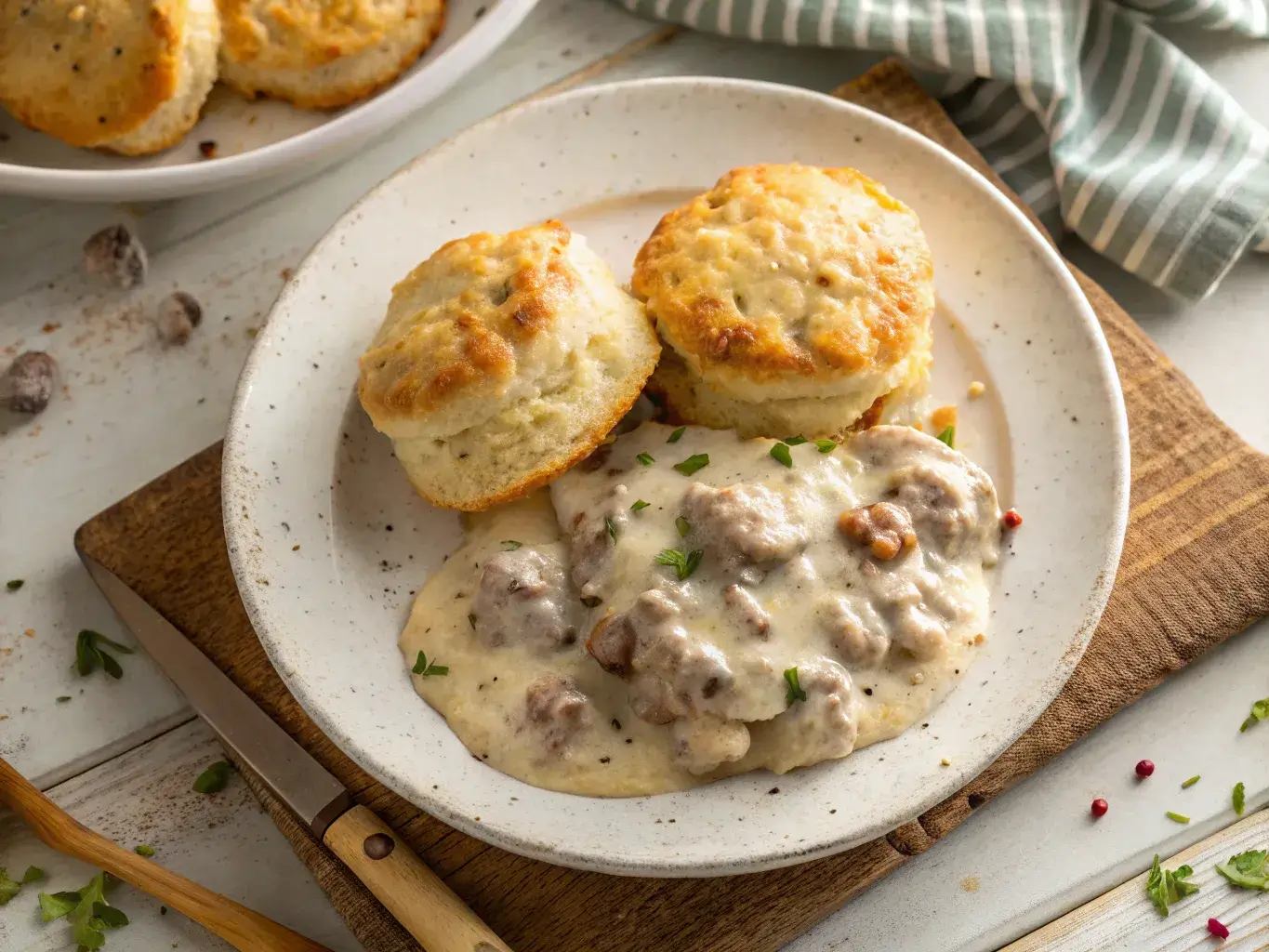Nutrition facts for biscuits and gravy reveal why this Southern classic is both beloved and debated at the breakfast table. Warm, rich, and dripping with flavor, the dish delivers comfort in every bite, but it also comes with a hefty dose of calories, fat, and carbs.
In this complete guide, we’ll break down the calorie count, protein content, and fat composition, while also exploring healthier swaps that don’t sacrifice taste. Whether you savor traditional sausage gravy over buttery biscuits or prefer a lighter version, knowing exactly what’s on your plate helps you enjoy this comfort meal more mindfully.
Don’t miss our guide to Homemade Biscuit Nutrition for an even deeper dive into biscuit breakdowns.
Introduction to Biscuits and Gravy Nutrition
What Makes Biscuits and Gravy So Popular?
Rooted in Southern American cuisine, biscuits and gravy are known for their creamy texture and hearty taste. This breakfast combination typically features soft, flaky biscuits topped with thick sausage gravy made from pan drippings, milk, and flour.
People love the dish because it’s:
- Comforting: Warm and filling, perfect for a cozy morning
- Hearty: Contains fats and proteins that satisfy quickly
- Customizable: You can modify ingredients for diet needs
But with richness comes responsibility especially when you’re tracking macros, calories, or sodium.
Why Understanding the Nutrition Is Important
It’s easy to underestimate the calorie count when a meal looks homemade and fresh. But biscuits and gravy often contain hidden sodium, refined carbs, and saturated fats that can add up fast—especially when eaten in large portions.
Knowing the nutrition facts for biscuits and gravy empowers you to:
- Manage weight loss or fitness goals
- Make substitutions that reduce fat and sodium
- Decide how often this meal fits into your plan
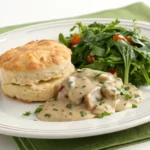
Nutrition Facts for Biscuits and Gravy – The Best 2025 Health Breakdown
- Total Time: 40 minutes
- Yield: 4 servings 1x
Description
A hearty Southern classic breakfast: flaky homemade biscuits smothered in rich, creamy sausage gravy. Perfect comfort food for weekend brunches or special mornings.
Ingredients
- For the biscuits:
- 2 cups all-purpose flour
- 1 tbsp baking powder
- 1/2 tsp baking soda
- 1/2 tsp salt
- 6 tbsp cold unsalted butter, cubed
- 3/4 cup whole milk or buttermilk
- For the sausage gravy:
- 1/2 lb breakfast sausage
- 2 tbsp unsalted butter (optional, if sausage is lean)
- 1/4 cup all-purpose flour
- 2 cups whole milk
- Salt and black pepper to taste
- 1/4 tsp crushed red pepper flakes (optional)
Instructions
- 1. Preheat oven to 425°F (220°C). Line a baking sheet with parchment paper.
- 2. In a large bowl, whisk flour, baking powder, baking soda, and salt.
- 3. Cut in the cold butter until the mixture resembles coarse crumbs.
- 4. Add milk and stir just until dough forms. Pat into 1-inch thick dough and cut biscuits.
- 5. Place biscuits on baking sheet and bake 12–15 minutes until golden brown.
- 6. While biscuits bake, cook sausage in a skillet over medium heat until browned and cooked through.
- 7. If needed, add butter to make about 2 tablespoons of fat total.
- 8. Sprinkle flour over sausage and stir, cooking for 1–2 minutes.
- 9. Gradually add milk while stirring constantly. Simmer until thickened, about 5 minutes.
- 10. Season with salt, pepper, and red pepper flakes if using.
- 11. Split warm biscuits and top with sausage gravy. Serve immediately.
Notes
- For richer biscuits, use buttermilk and brush the tops with melted butter.
- Use spicy sausage for extra flavor, or add herbs like thyme or sage to the gravy.
- Gravy thickens as it cools—add a splash of milk to loosen when reheating.
- Leftover gravy can be stored in the fridge for up to 3 days.
- Prep Time: 20 minutes
- Cook Time: 20 minutes
- Category: Breakfast
- Method: Baking + Stovetop
- Cuisine: Southern American
Nutrition
- Serving Size: 2 biscuits with gravy
- Calories: 560
- Sugar: 5g
- Sodium: 880mg
- Fat: 34g
- Saturated Fat: 18g
- Unsaturated Fat: 12g
- Trans Fat: 0g
- Carbohydrates: 46g
- Fiber: 2g
- Protein: 16g
- Cholesterol: 70mg
Keywords: biscuits and gravy, sausage gravy, southern breakfast, comfort food
Basic Nutrition Facts for Biscuits and Gravy
Macronutrient Breakdown (Calories, Fat, Protein, Carbs)
Let’s start with the basics. A traditional serving of 1 large biscuit with ½ cup of sausage gravy typically includes:
| Nutrient | Amount (Approx.) |
|---|---|
| Calories | 450–650 kcal |
| Total Fat | 25–38 g |
| Saturated Fat | 10–15 g |
| Carbohydrates | 28–35 g |
| Protein | 10–14 g |
| Sodium | 900–1,200 mg |
Looking for inspiration? Try our Maple Biscuit Recipe for a lighter, slightly sweet twist on traditional biscuits.
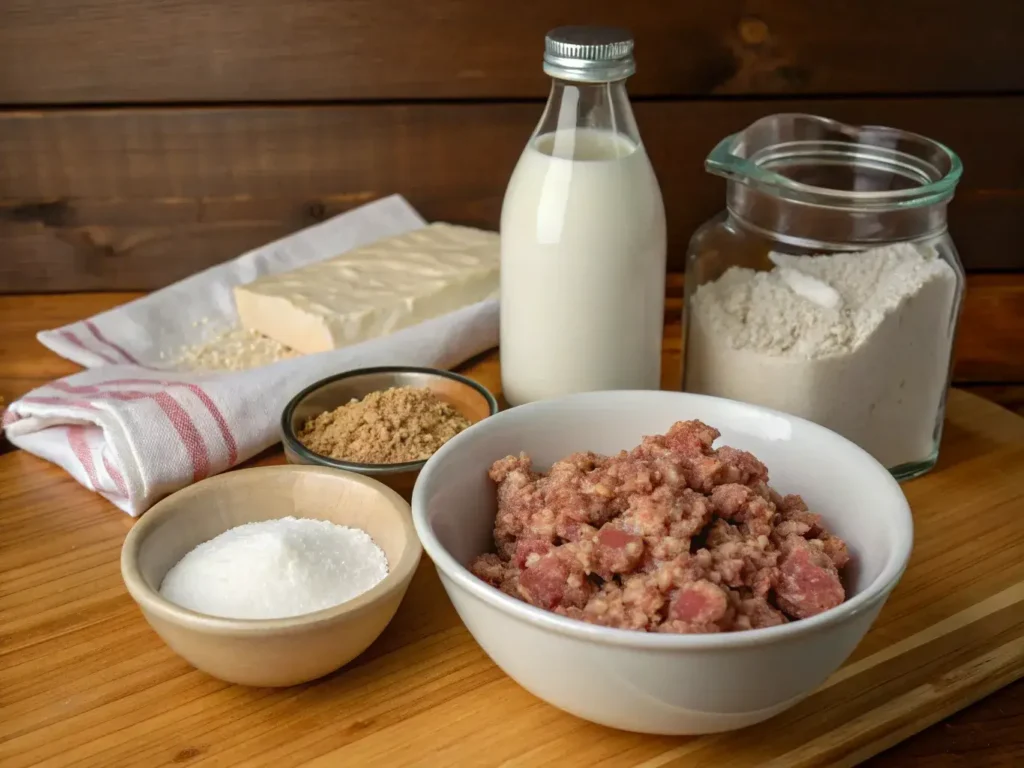
Typical Serving Size and Nutritional Range
- One biscuit (medium, ~55g): 180–220 calories
- ½ cup sausage gravy: 250–400 calories depending on fat content
- Combined dish: 450–650 calories
Higher-fat sausages and whole milk push these numbers up, while lean ground turkey and low-fat milk can bring them down.
Calories in a Homemade Biscuit with Gravy
Calories from the Biscuit vs. the Gravy
Each component contributes differently to the total calorie count:
| Component | Calories | Notes |
|---|---|---|
| Biscuit (homemade) | 180–220 | White flour and butter-based |
| Gravy (½ cup, pork) | 250–400 | Sausage fat, flour, milk base |
| TOTAL (average) | 450–600 | Varies based on ingredients used |
Homemade versions may include less preservatives and additives, but they can still be calorie-dense.
Check out Lemon Sandwich Biscuits if you’re looking for a biscuit variation that’s lighter and citrusy.
Calorie Chart Based on Common Ingredients
| Ingredient | Calories (per serving) |
|---|---|
| Pork sausage (2 oz) | 200 |
| Whole milk (½ cup) | 75 |
| All-purpose flour (1 tbsp) | 30 |
| Butter (1 tbsp in biscuit) | 100 |
| Biscuit (homemade, 55g) | 200 |
Use lean protein and alternative flours to cut calories significantly. Swapping almond milk for whole milk can reduce 50+ calories per serving.
Nutritional Value of Homemade Biscuits
Standard Ingredients and Their Impact
Most homemade biscuits are made with:
- All-purpose flour – high in simple carbs, low in fiber
- Butter or shortening – high in saturated fat
- Milk or buttermilk – adds protein and calcium
- Baking powder/soda & salt – contributes sodium
- Optional sugar – minimal but adds quick carbs
A standard biscuit (55g) contains:
| Nutrient | Amount |
|---|---|
| Calories | 180–220 kcal |
| Carbs | 23–25 g |
| Fat | 9–12 g |
| Saturated Fat | 4–7 g |
| Protein | 3–4 g |
| Sodium | 300–500 mg |
These values contribute significantly to the nutrition facts for biscuits and gravy, especially when paired with a rich sausage gravy.
Healthier Homemade Biscuit Variations
You can modify your biscuit recipe for better nutritional value by:
- Using whole wheat or almond flour instead of white
- Replacing butter with Greek yogurt or avocado oil
- Skipping added sugar entirely
- Using low-fat buttermilk instead of whole milk
Discover great ideas like our Homemade Biscuit Nutrition Guide for more healthy swaps and comparisons.
Gravy Nutrition – Calories, Fat, and Sodium
Types of Gravy and Their Nutritional Profiles
Gravy is where calories and saturated fats climb quickly. Here’s a breakdown of common gravy types:
| Gravy Type | Calories (½ cup) | Fat (g) | Sodium (mg) |
|---|---|---|---|
| Sausage Gravy | 250–400 | 20–30 | 800–1,200 |
| Cream Gravy | 180–260 | 15–22 | 600–900 |
| Mushroom Gravy | 120–160 | 8–12 | 400–600 |
| Turkey Gravy (lean) | 90–120 | 5–8 | 300–500 |
Gravy made from pan drippings is often high in saturated fat. Opting for a broth-based or milk-alternative version can make a dramatic nutritional difference.
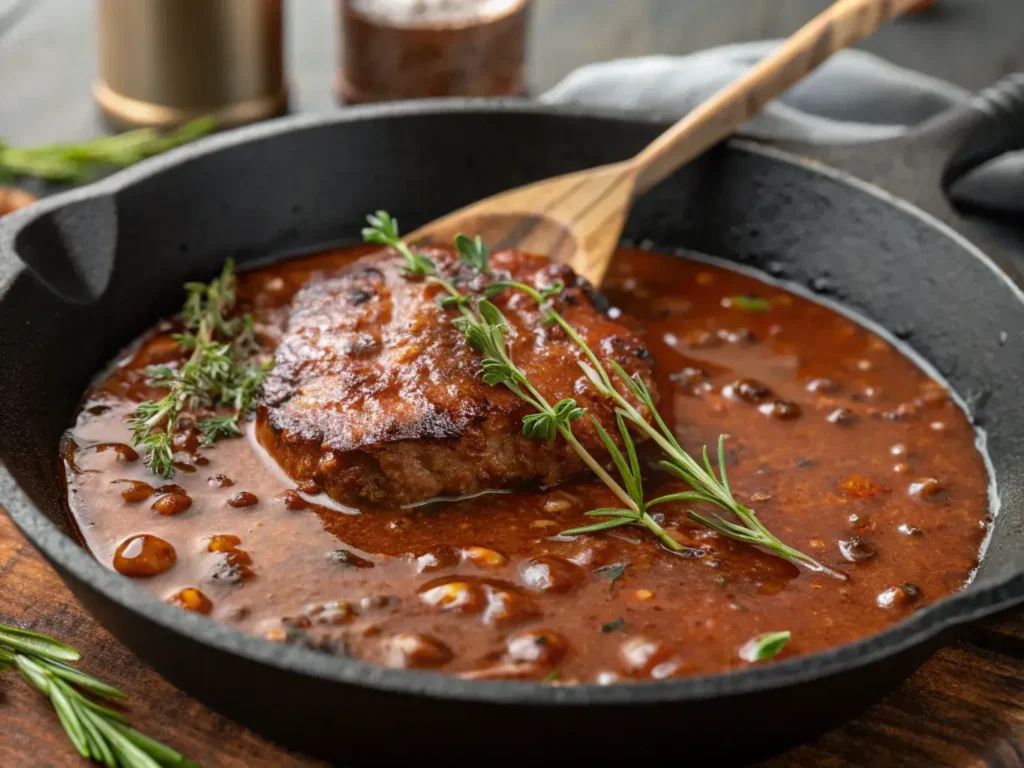
How Sausage Gravy Compares to Other Versions
Sausage gravy, the Southern favorite, typically uses:
- Pork sausage (high in fat)
- Butter or grease
- Whole milk
- White flour
Compared to lighter gravies, sausage gravy ranks highest in saturated fat and sodium, making it the least diet-friendly option, yet it’s the most flavorful. Swapping pork for ground turkey or chicken sausage and using unsweetened almond milk can save up to 150 calories per serving.
Are Biscuits and Gravy Healthy or Not?
Pros and Cons of the Dish
Pros:
- Satisfying and filling – May prevent overeating later
- Homemade versions allow ingredient control
- Good protein source when meat is included
- Comfort food appeal for emotional satisfaction
Cons:
- High in saturated fats and sodium
- Low in fiber and micronutrients
- May exceed daily sodium limits in one serving
- Refined carbs can spike blood sugar levels
When It Fits into a Balanced Diet
Biscuits and gravy can be part of a balanced diet if:
- You limit portions (½ cup gravy + 1 biscuit)
- Use lean meats and milk alternatives
- Make it a treat, not a daily staple
- Pair it with high-fiber sides like sautéed greens or fresh fruit
Don’t miss our Healthy Desserts with Dates for post-breakfast sweets that won’t wreck your progress.
Tips for Making Biscuits and Gravy Healthier
Ingredient Swaps to Reduce Calories and Fat
If you’re aiming to improve the nutrition facts for biscuits and gravy, start with the ingredients. Here are some easy swaps:
| Traditional | Healthier Alternative |
|---|---|
| Pork sausage | Turkey or chicken sausage |
| Whole milk | Unsweetened almond milk |
| Butter in biscuits | Greek yogurt or avocado oil |
| White flour | Almond or oat flour |
| Salt-heavy gravy base | Low-sodium broth + herbs |
Swapping even one of these can shave off 100–150 calories per serving.
Cooking Techniques to Enhance Nutrition
- Bake instead of fry: Reduces extra oil
- Use smaller biscuit cutters: Keeps portions in check
- Skim fat from pan drippings: Lowers saturated fat
- Add vegetables like mushrooms or spinach to gravy: Boosts fiber and nutrients
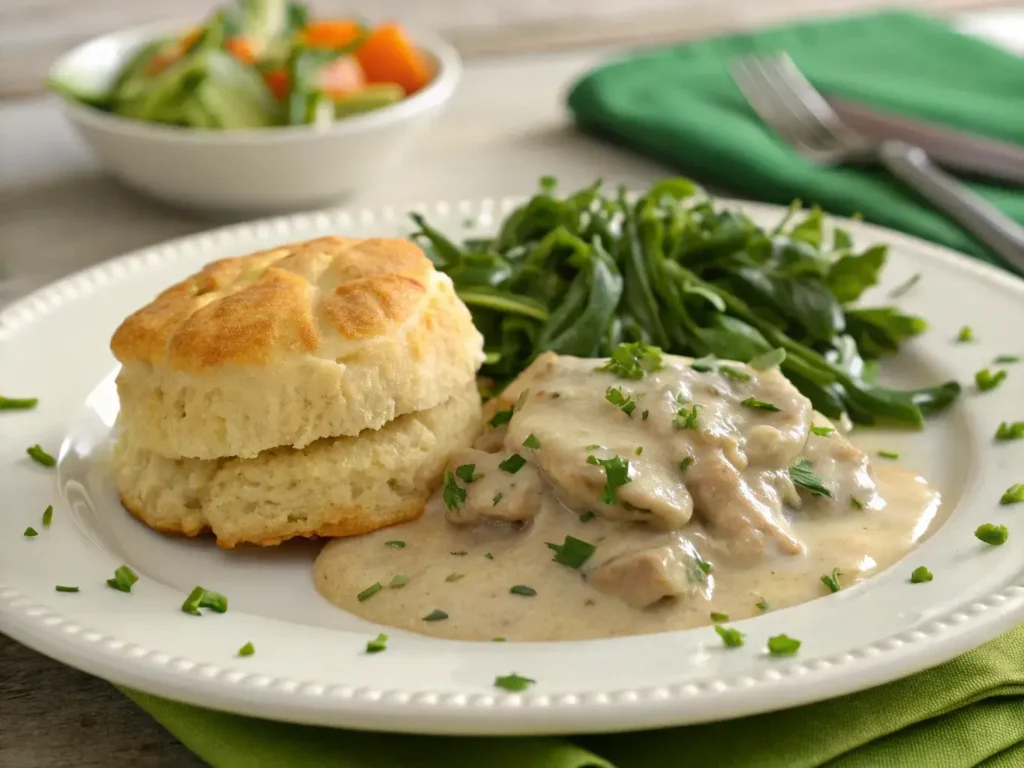
Diet-Specific Considerations
Low-Carb, Low-Fat, and Gluten-Free Options
For Low-Carb Diets:
- Use almond flour biscuits
- Make keto sausage gravy with heavy cream and coconut flour
For Low-Fat Diets:
- Skip sausage and make gravy with low-fat milk
- Use egg whites and whole wheat biscuits
For Gluten-Free Diets:
- Use gluten-free biscuit mix or oat flour
- Thicken gravy with cornstarch instead of wheat flour
Are Biscuits and Gravy Okay for Weight Loss Diets?
Yes, if portioned and prepared mindfully. Choose one biscuit, use lean protein, and skip the extra butter. Keep total calories under 500, and it fits easily into most calorie-restricted meal plans.
Sample Meal Plans & Light Recipes
Healthier Biscuits and Gravy Recipe Breakdown
Serves: 4
Time: 30 minutes
Nutrition (per serving):
- Calories: 390
- Fat: 16g
- Carbs: 28g
- Protein: 18g
- Sodium: 580mg
Ingredients
- 1 cup almond flour
- 1/2 cup Greek yogurt
- 2 tsp baking powder
- 1/2 tsp salt
- 8 oz turkey sausage
- 1 tbsp whole wheat flour
- 1/2 cup unsweetened almond milk
- 1/4 tsp black pepper
Instructions
- Preheat oven to 400°F.
- Mix biscuit ingredients, cut into circles, and bake for 12–15 mins.
- Brown sausage, sprinkle in flour, and stir.
- Slowly add almond milk and simmer until thickened.
- Serve gravy over warm biscuits.

How to Fit It into Your Weekly Plan
| Day | Meal |
|---|---|
| Monday | Turkey sausage biscuit + sautéed greens |
| Thursday | Gluten-free biscuit with mushroom gravy |
| Sunday | Keto gravy over almond flour biscuit |
Frequently Asked Questions (FAQs)
What is the nutritional value of biscuits and gravy?
One serving usually contains 450–650 calories, 25–38g fat, and 900–1,200mg sodium. Protein is moderate at 10–14g, depending on sausage used.
How many calories in a homemade biscuit with gravy?
About 500–550 calories on average. The biscuit accounts for 180–220, while the gravy adds 250–330 depending on the fat and flour used.
What is the nutritional value of homemade biscuits?
Homemade biscuits offer 180–220 calories, 9–12g fat, 22–25g carbs, and 3–4g protein per medium biscuit. Whole wheat flour boosts fiber slightly.
Are biscuits and gravy good for a diet?
They can be with smart swaps and portion control. Traditional recipes are calorie-dense, but lightened versions can fit most balanced meal plans.
Conclusion
Biscuits and gravy may be a classic indulgence, but that doesn’t mean they’re off-limits. By understanding the nutrition facts for biscuits and gravy, you can make better ingredient choices, control portion sizes, and still enjoy every creamy bite. Whether you’re managing weight, lowering sodium, or just trying to eat smarter, it’s all about balance. From lean meats to almond flour biscuits, the path to a healthier Southern breakfast starts in your own kitchen.

